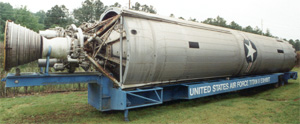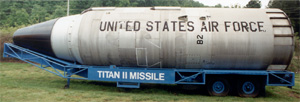
|
Glen L. Martin Company Titan I ICBM |
 |
The Titan I is a two-stage missile that was developed in the event that the Atlas program was a failure.
The Titan I was developed by the Glen L. Martin Company (now Lockheed Martin) as an Intercontinental
Ballistic Missile. Designated SM-68 (Strategic Missile-68), the Titan I was America's
second ICBM, and the first two-stage ICBM. Both stages were powered by LOX (Liquid Oxygen) and alcohol. As evident in
the picture above, the first stage had two engines, and the second had a single engine.
Work on the Titan I started in 1955. The first missile was
delivered on June 17, 1958, and testing began. On February 6, 1959 (on the third attempt), a Titan I with a dummy
second stage was successfully launched from Complex 15. Shortly afterwards, testing began on the two-stage version.
After a series of failures, a Titan I was launched on January 27, 1960 and traveled 2200 miles before splashing down.
Testing continued into 1961, and the Titan I was subsequently delivered to Air Force missile silos then
declared operational in April of 1962.
A total of 54 Titan I missiles were deployed throughout
the United States. By April of 1965, after four years on alert, the Titan I missiles were removed from service.
| Titan I specifications and performance |
| Length |
98 ft. |
Weight |
22,000 lbs. |
| Thrust |
First stage: 300,000 lbs.
Second stage: 80,000 lbs. |
Speed |
15,000 MPH |
| Apogee |
500 miles |
Range |
5500 nautical miles |
| Warhead |
W-38 or W-49 thermonuclear (4 MT) |

| Glen L. Martin Company Titan II (first stage) |
 |
|

| Glen L. Martin Company Titan II (second stage) |
 |
|
The Titan II was similar to the Titan I, but was much more powerful. Designated as LGM-25C, the Titan II
was the largest missile ever deployed by the U.S. Air Force. The missile was longer and heavier than its
predecessor, and used new engines and different propellants (a 50/50 mix of hydrazine and
unsymetrical dimethylhydrazine, with nitrogen tetroxide oxidizer).
The greater thrust on the Titan II also enabled it to insert
payloads into Earth orbit. Unlike the Titan I, which was strictly used as an ICBM, the Titan II played an important
role in the Gemini program as the vehicle for all of the manned missions.
| Titan II specifications and performance |
| Length |
103 ft. |
Weight |
330,000 lbs. |
| Thrust |
First stage: 430,000 lbs.
Second stage: 100,000 lbs. |
Speed |
15,000 MPH |
| Apogee |
600 miles |
Range |
5500 nautical miles |
| Warhead |
W-53 thermonuclear (9 MT) |



